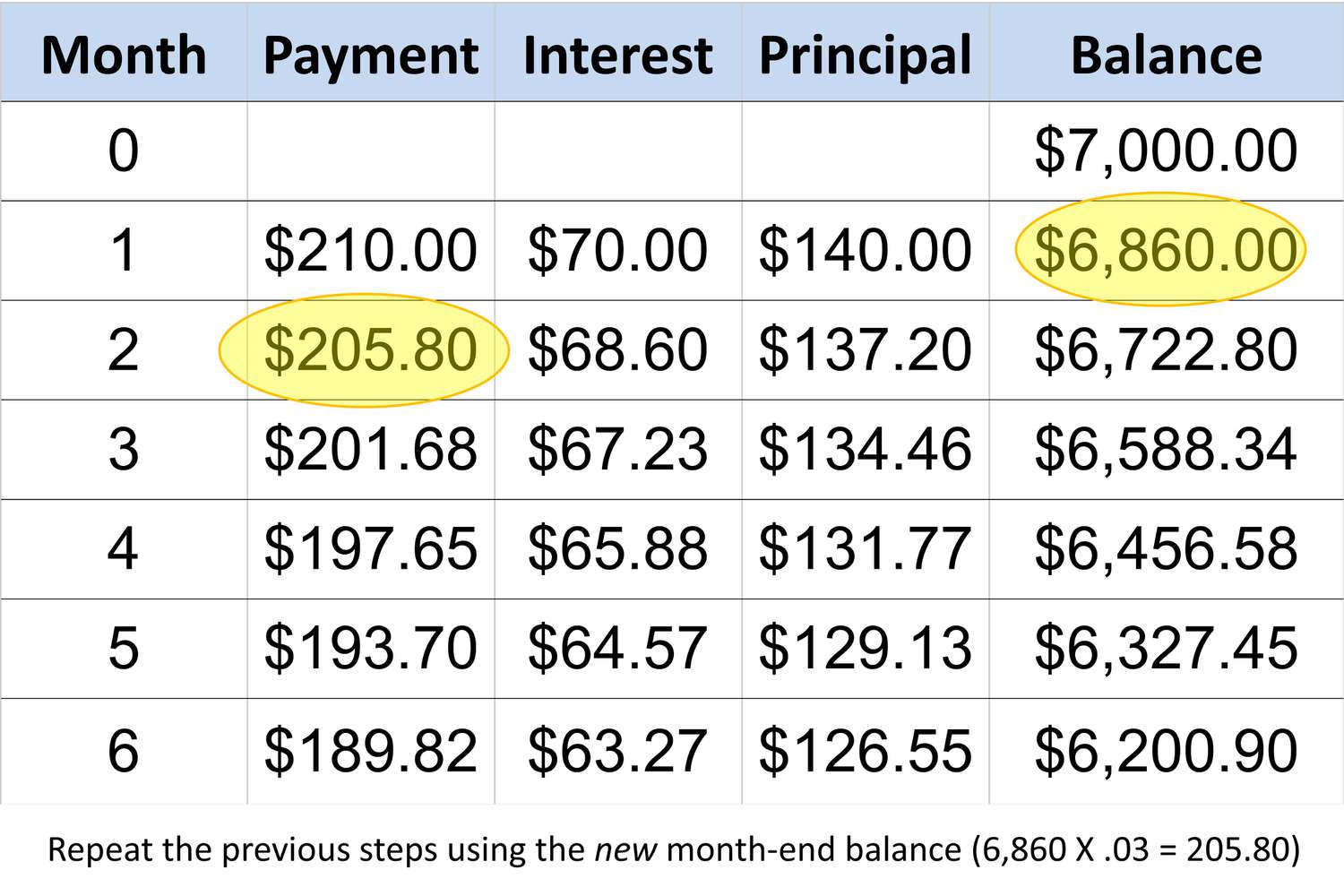Home>Finance>What Percentage Is Minimum Payment On Credit Card


Finance
What Percentage Is Minimum Payment On Credit Card
Published: February 25, 2024
Learn about the minimum payment on credit cards and what percentage it constitutes. Discover how it impacts your finances and credit score. Find out more about finance and credit management.
(Many of the links in this article redirect to a specific reviewed product. Your purchase of these products through affiliate links helps to generate commission for LiveWell, at no extra cost. Learn more)
Table of Contents
Introduction
Understanding the Basics of Minimum Credit Card Payments
Credit cards are a ubiquitous financial tool in today's world, offering convenience and flexibility for making purchases and managing expenses. However, it's crucial for cardholders to understand the concept of minimum payments and their significance in maintaining healthy financial habits. In this article, we will delve into the intricacies of minimum payments on credit cards, exploring how they are calculated, the factors influencing their determination, and the implications of paying only the minimum amount due.
Understanding the minimum payment requirement is essential for responsible credit card management. While it may seem convenient to pay only the minimum amount each month, this approach can lead to long-term financial challenges due to accruing interest and extended repayment periods. By gaining insight into the dynamics of minimum payments, individuals can make informed decisions about managing their credit card obligations and avoiding potential debt traps.
Throughout this article, we will dissect the mechanics of minimum payments, shed light on the factors that influence their calculation, and emphasize the importance of paying more than the minimum to safeguard one's financial well-being. Moreover, practical tips for effectively managing credit card payments will be provided to empower readers with actionable strategies for responsible financial stewardship.
Join us on this enlightening journey as we unravel the mysteries of minimum credit card payments, empowering you to navigate the complex terrain of credit card management with confidence and prudence.
Understanding Minimum Payments on Credit Cards
Minimum payments on credit cards represent the lowest amount that cardholders are required to pay each month to maintain their accounts in good standing. While this may seem like a convenient option for managing finances, it is essential to comprehend the implications of making only the minimum payment. By gaining a deeper understanding of minimum payments, individuals can make informed decisions about their financial responsibilities and avoid potential pitfalls.
When cardholders receive their monthly credit card statements, they typically encounter a section detailing the minimum payment due. This amount is calculated based on various factors, including the outstanding balance, interest charges, and a predetermined percentage of the total balance. While the specific calculation method may vary among credit card issuers, it is crucial for cardholders to grasp the underlying principles governing minimum payments.
One of the key aspects to consider is the impact of making only the minimum payment on the overall cost of credit. By paying only the minimum amount due, cardholders incur interest on the remaining balance, leading to a prolonged repayment period and increased interest expenses. This can potentially result in paying significantly more than the original purchase amount over time, making it imperative for individuals to assess the long-term implications of minimum payments.
Moreover, understanding the relationship between minimum payments and credit utilization is vital. Credit utilization, which refers to the ratio of credit card balances to credit limits, plays a significant role in determining individuals’ credit scores. By consistently making only the minimum payment, cardholders may inadvertently elevate their credit utilization ratio, potentially impacting their creditworthiness. This underscores the importance of strategically managing credit card payments to maintain a healthy credit profile.
As we delve deeper into the intricacies of minimum payments on credit cards, it becomes evident that a comprehensive comprehension of this fundamental aspect of credit card management is indispensable. By equipping oneself with the knowledge to navigate the nuances of minimum payments, individuals can make informed decisions that align with their financial goals and aspirations.
Factors Affecting Minimum Payments
Several factors influence the calculation of minimum payments on credit cards, shaping the amount that cardholders are required to pay each month. Understanding these factors is crucial for individuals seeking to manage their credit card obligations effectively and make informed decisions about their financial responsibilities. By gaining insight into the elements that impact minimum payments, cardholders can navigate the intricate terrain of credit card management with prudence and foresight.
One of the primary factors affecting minimum payments is the outstanding balance on the credit card. As the balance fluctuates based on purchases, repayments, and accrued interest, the minimum payment amount adjusts accordingly. A higher outstanding balance typically results in a proportionally higher minimum payment, emphasizing the significance of monitoring and managing credit card expenditures to mitigate financial strain.
Interest charges also play a pivotal role in determining minimum payments. The annual percentage rate (APR) applied to the outstanding balance directly influences the amount of interest accrued. Consequently, a higher APR leads to increased interest expenses, impacting the minimum payment requirement. By comprehending the implications of interest charges, cardholders can make informed decisions about managing their credit card balances and mitigating the long-term cost of credit.
Furthermore, some credit card issuers incorporate a predetermined percentage of the total balance into the minimum payment calculation. This percentage-based approach ensures that cardholders contribute a proportional amount towards reducing their outstanding balances each month. While this mechanism aims to facilitate steady progress in debt repayment, it underscores the importance of understanding the specific terms and conditions outlined by credit card providers.
Additionally, certain credit card agreements may include fees, such as annual fees or late payment penalties, which can impact the minimum payment due. These additional charges contribute to the overall balance and subsequently influence the minimum payment requirement. Cardholders must remain cognizant of such fees and their implications on minimum payments to effectively manage their credit card accounts.
By comprehending the multifaceted factors that influence minimum payments on credit cards, individuals can proactively navigate the intricacies of credit card management. Empowered with this knowledge, cardholders can make informed decisions, strategically allocate their financial resources, and cultivate responsible financial habits that align with their long-term goals.
How Minimum Payments Are Calculated
Understanding the methodology behind the calculation of minimum payments on credit cards is pivotal for individuals aiming to manage their financial obligations effectively. While the specific algorithms employed by credit card issuers may vary, certain fundamental principles underpin the determination of minimum payments. By unraveling the intricacies of this process, cardholders can gain insight into the factors shaping their minimum payment requirements and make informed decisions about their financial responsibilities.
One prevalent method for calculating minimum payments involves a combination of the outstanding balance, interest charges, and a predetermined percentage of the total balance. Credit card issuers typically set the minimum payment as a percentage of the total balance, often ranging from 1% to 3% of the outstanding amount. This approach ensures that the minimum payment adjusts in tandem with the fluctuating balance, reflecting the dynamic nature of credit card obligations.
Moreover, interest charges constitute a significant component of minimum payment calculations. The accrued interest, determined by the annual percentage rate (APR) applied to the outstanding balance, is factored into the minimum payment requirement. As the outstanding balance and interest charges evolve, the minimum payment amount adapts to reflect the changing financial dynamics, underscoring the interplay between credit card balances and minimum payments.
It is essential to recognize that credit card issuers may delineate specific terms and conditions governing minimum payments in cardholder agreements. These provisions elucidate the precise methodology employed for calculating minimum payments, shedding light on the intricacies of the process. By familiarizing themselves with the terms outlined by credit card providers, cardholders can gain clarity regarding the calculation of minimum payments and proactively manage their financial commitments.
Furthermore, some credit card agreements may incorporate a minimum fixed amount as part of the minimum payment requirement, ensuring that cardholders contribute a baseline sum towards reducing their outstanding balances. This mechanism provides a safeguard against nominal minimum payments that may not adequately address the evolving balance and interest charges, promoting responsible debt management practices.
By comprehending the underlying principles governing the calculation of minimum payments on credit cards, individuals can navigate the intricacies of credit card management with prudence and foresight. Equipped with this knowledge, cardholders can make informed decisions, strategically allocate their financial resources, and cultivate responsible financial habits that align with their long-term goals.
The Importance of Paying More Than the Minimum
While the minimum payment requirement on credit cards offers a degree of flexibility, it is imperative for cardholders to recognize the significance of paying more than the minimum each month. By surpassing the minimum payment, individuals can mitigate the long-term cost of credit, expedite debt repayment, and fortify their financial well-being. Understanding the advantages of paying more than the minimum empowers cardholders to make informed decisions about managing their credit card obligations and cultivating responsible financial habits.
One of the primary benefits of paying more than the minimum is the reduction of interest expenses. By allocating additional funds towards the outstanding balance, cardholders can diminish the amount of interest accrued, ultimately lowering the overall cost of credit. This proactive approach not only accelerates debt repayment but also enables individuals to save on interest expenses, fostering a more financially secure future.
Furthermore, exceeding the minimum payment facilitates a swifter reduction of the outstanding balance. As the surplus payments directly offset the principal amount, individuals can expedite the process of debt elimination, thereby alleviating the burden of long-term financial obligations. This proactive debt reduction strategy empowers cardholders to regain financial autonomy and pursue their economic aspirations with greater freedom.
By consistently paying more than the minimum, individuals can also fortify their creditworthiness. Responsible credit management, exemplified by proactive debt repayment practices, contributes to a positive credit profile. This, in turn, enhances individuals’ access to favorable credit terms, such as lower interest rates and higher credit limits, while bolstering their overall financial standing.
Moreover, embracing a proactive approach to debt repayment fosters a sense of financial discipline and empowerment. By prioritizing higher payments, individuals cultivate prudent financial habits, instilling a sense of control over their economic well-being. This proactive mindset transcends credit card management, permeating various facets of individuals’ financial lives and fostering a holistic approach to responsible money management.
Ultimately, paying more than the minimum on credit cards not only yields immediate financial benefits but also cultivates a mindset of proactive financial stewardship. By recognizing the advantages of surpassing the minimum payment requirement, individuals can chart a course towards financial liberation, empowered by informed decisions and responsible financial practices.
Tips for Managing Credit Card Payments
Effectively managing credit card payments is essential for maintaining sound financial health and mitigating potential debt challenges. By implementing strategic approaches to credit card management, individuals can navigate the complexities of credit obligations with confidence and prudence. The following tips offer actionable guidance for managing credit card payments responsibly and cultivating a solid foundation for long-term financial well-being.
- Regularly Monitor Your Statements: Stay vigilant by reviewing your credit card statements regularly. Scrutinize transactions, verify the accuracy of charges, and promptly report any discrepancies to your card issuer.
- Understand Your Minimum Payment: Familiarize yourself with the factors influencing the calculation of your minimum payment. Comprehend the implications of paying only the minimum and strive to allocate additional funds towards reducing your outstanding balance.
- Create a Payment Schedule: Establish a consistent payment schedule to ensure timely settlement of your credit card dues. Adhering to a structured payment routine can help you avoid late fees and maintain a positive payment history.
- Strategically Allocate Your Payments: If you carry balances on multiple credit cards, consider prioritizing higher payments towards accounts with higher interest rates or lower promotional rates to expedite debt repayment.
- Set Realistic Budgets: Develop realistic budgets that encompass your credit card payments. Strive to align your expenditures with your financial capabilities to avoid accumulating excessive credit card debt.
- Explore Automated Payments: Consider setting up automatic payments for the minimum amount due to ensure timely settlements. However, remain mindful of your overall financial obligations to avoid potential overdrafts.
- Seek Lower Interest Rates: Explore opportunities to negotiate lower interest rates with your credit card issuer. A reduced APR can alleviate the financial burden and facilitate more efficient debt repayment.
- Exercise Prudent Credit Utilization: Maintain a balanced approach to credit utilization by refraining from maxing out your credit limits. Strive to keep your credit card balances well below the assigned limits to bolster your creditworthiness.
- Utilize Rewards Wisely: If your credit card offers rewards or cashback incentives, leverage them judiciously. Maximize the benefits of rewards programs while refraining from overspending to earn rewards.
- Seek Professional Assistance if Needed: If you encounter challenges in managing your credit card payments or experience financial distress, consider seeking guidance from reputable financial advisors or credit counseling services.
By incorporating these tips into your credit card management practices, you can proactively navigate the intricacies of credit obligations, fortify your financial resilience, and cultivate responsible financial habits that align with your long-term goals.
Conclusion
As we conclude our exploration of minimum credit card payments and effective credit card management, it becomes evident that a comprehensive understanding of these financial dynamics is indispensable for individuals seeking to maintain sound financial health. Minimum payments, while offering a degree of flexibility, necessitate careful consideration and strategic management to mitigate potential long-term financial challenges.
By comprehending the factors influencing minimum payments, the methodology behind their calculation, and the advantages of paying more than the minimum, individuals can make informed decisions about their credit card obligations. Embracing proactive debt repayment strategies and cultivating responsible financial habits empowers individuals to navigate the complexities of credit card management with confidence and prudence.
Furthermore, the practical tips provided for managing credit card payments offer actionable guidance for individuals striving to fortify their financial well-being. From monitoring statements and understanding minimum payments to creating structured payment schedules and exercising prudent credit utilization, these strategies equip individuals with the tools to navigate credit obligations effectively.
Ultimately, responsible credit card management extends beyond mere financial transactions; it embodies a mindset of proactive financial stewardship and disciplined money management. By implementing the insights gleaned from this exploration, individuals can chart a course towards financial liberation, empowered by informed decisions and prudent financial practices.
As we bid adieu to this enlightening journey through the intricacies of credit card management, may the knowledge gained serve as a compass guiding you towards a future marked by financial resilience, informed decision-making, and enduring prosperity.














